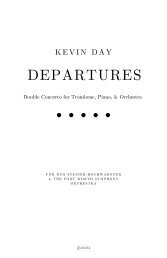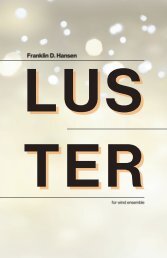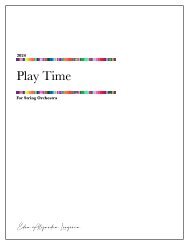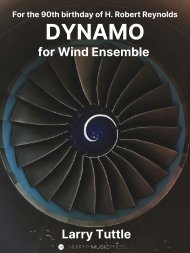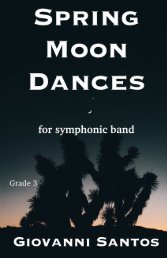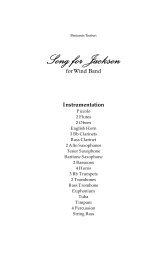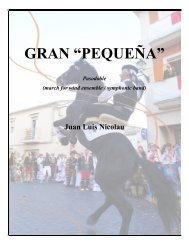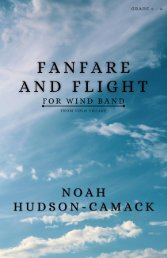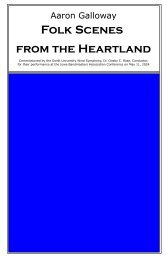Tapestries Score
Create successful ePaper yourself
Turn your PDF publications into a flip-book with our unique Google optimized e-Paper software.
combination with the finger cymbals, castanets and maracas, sound a bit “Spanish”. This material<br />
from m.76-85 will return in the transition to closure section in m.221-227.<br />
The countermelody played by the oboe and horn beginning at m.88 will also return in the<br />
transition to closure at m.211-218.<br />
Second Transition m.97-119<br />
I chose the brass section here to evoke the sounds of Spain, and as they develop material from m.<br />
76, it gives way to another version of the descending motif beginning at m.103. As other<br />
instruments layer in from m.108-114, the music shifts to a spotlight on the tuba, who begins a<br />
repetitive figure with the other brass instruments at m.116. This section is designed to support the<br />
molto accelerando, in which the conductor can relax into a two pattern by m.119 or 120, if desired.<br />
Percussion Break m.120-157<br />
Make sure and have your djembe players view the links above to see their basic pattern<br />
demonstrated on YouTube. After the percussionists layer in, the djembes take turns soloing. You<br />
may find you need to have the percussionists who are not soloing play even quieter than the<br />
marked dynamics, so as to allow the soloist’s line to come through.<br />
Introduction (to the third instance of the Theme) m.158-169<br />
New language is introduced in the quarter note triplet pattern from m.163-164. The clarinet line<br />
from beat 4 of m.165 into m.166 mimics the language first introduced in m.59 by itself and the<br />
oboe, except in an elongated version. The entrance of the open fifth in the tuba and trombone<br />
establishes C firmly as the tonic of this section, in the fifth mode of the f melodic minor scale.<br />
The marimba mimics the ostinato first heard in m.34 beginning in m.168.<br />
Third instance of the Theme m.170-195<br />
The section begins with fragments of the Theme, returning in horns and clarinets, which were the<br />
instruments that first introduced it in m.9. The oscillating interval of a major second returns<br />
beginning in the trombone and tuba at m.170-172. At the trumpet entrances at m.176 you can hear<br />
the beginning of the line that typically leads to the descending motif. The tpt. 2 and cl. 2 allude to<br />
this motif in elongated fashion from m.178-180. A flute line similar to the one found in m.28<br />
returns in the lower octave at m.176-177. At m.187-195 a longer, canonized version of m.15-18<br />
occurs, leading to a return of the material from the beginning.<br />
Transition to Closure m.196-227<br />
This exciting section begins with a return of the material from the very beginning of the work,<br />
with interjections from the djembes in place of the previous snare, bass drum, and timpani. One<br />
last full statement of the Theme occurs at m.204-219, synthesized with the ostinato, tuba and<br />
timpani hits, and hand claps. The version of the descending line from the first transition sections is<br />
heard at m.210, with interjections from the horn, playing its countermelody from m.88, this time<br />
harmonized in the thirds with the trumpet 1 part. The material from m.76-85 returns in m.<br />
221-227, as the trombones play their figure from m.30, and the tuba plays a quickly osillating circle<br />
of fifths line. The big statement beginning on beat 3 of m.225 and m.226 recalls the line from m.<br />
84 (beat 3) and m.85, except this time transposed up a fifth in the key of C.<br />
Closing m.231-end<br />
One final partial statement of the Theme occurs, offset by a major third and gives way to the<br />
quarter note triplet figure from m.163, which descends through the octaves. Several instruments<br />
give one last mention of the figure from m.59. The low brass plays a circle of fifths pattern –<br />
notice it address the 5 th and root of all three Bb, F and C key signatures in the line (which is how<br />
the timpani notes were chosen from the beginning). The piece ends with the three notes from the<br />
three key centers, voiced in perfect fifth intervals, with the African drums and timpani interjecting.





